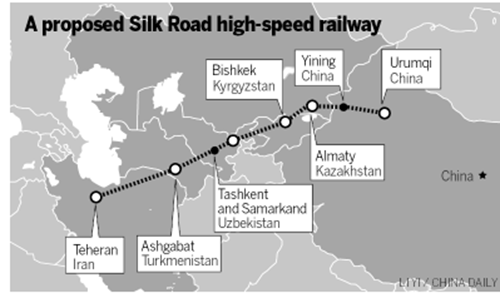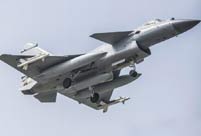


A proposed Silk Road high-speed railway. [Li Yi/China Daily]
China's railway authority has proposed a Silk Road high-speed railway connecting the country's northwest region to West Asia via Central Asia, a plan it said would overcome the cross-border connectivity problem of different rail standards.
He Huawu, chief engineer of China Railway Corp, put forward the proposal at a Thursday forum on the One Belt, One Road Initiative hosted by China Civil Engineering Society.
His proposed route was from China's Urumqi and Yining to Almaty in Kazakhstan, then to Bishkek in Kyrgyzstan, Tashkent and Samarkand in Uzbekistan, Ashgabat in Turkmenistan and finally blending into West Asia's network through Teheran, Iran.
The northeast-southwest line would be complementary to the existing railway network in central Asian nations, which mostly run southeast to northwest toward Moscow, He said. What's more important, it could get rid of the incompatibility between this region's wide-gauge track systems and China's standard-gauge system.
For years, the 1.52-meter track standard adopted in Central Asia has been a headache for logistics managers because it is not based on the 1.435 meter standard track adopted in China and most other parts of the world. Changing gauges at the border takes days for cargo and significantly cuts railway transport's competitiveness against shipping by sea.
It is unlikely now to persuade those countries to change their existing railways, He said, but the high-speed rail he envisions along the new route would connect seamlessly to China's network and other regions. That's because the worldwide standard for fast rail is the 1.435 meter variety, so a new line could be built based on it.
"The Khorgos station bordering Kazakhstan last year handled less than 17 million metric tons of cargo running at full capacity, but beyond the station, the east-west annual cargo transportation capacity is 100 million tons," He said.
The bottleneck undermined the idea of a large-capacity corridor.
"Increased container traffic and sea container traffic moved by land instead could justify the cost of building the line," he said.
According to He, container trains and passenger trains could run on the same route. The only difference would be speed. A passenger train could run at 250 to 300 kilometers per hour, while a container train could run at 120 km/h.
Other experts cautioned that an Asian railway link has been under discussion for a long time and has not materialized mainly because of various geopolitical concerns of the countries alone the route.
 J-10B fighters with homegrown engine in test fligh
J-10B fighters with homegrown engine in test fligh Photos of U.S. Navy intruding in South China Sea released
Photos of U.S. Navy intruding in South China Sea released Cats who immediately regretted their life choices in photographs
Cats who immediately regretted their life choices in photographs Beautiful girl from police college becomes Internet hit
Beautiful girl from police college becomes Internet hit 10 tons of copper coins unearthed in 2,000-yr old tomb
10 tons of copper coins unearthed in 2,000-yr old tomb In Pics: Amazing Chinese fighters
In Pics: Amazing Chinese fighters
 Chinese, U.S. navies hold first-ever joint exercise in the Atlantic
Chinese, U.S. navies hold first-ever joint exercise in the Atlantic When a Chinese woman marries an Indian man
When a Chinese woman marries an Indian man Photos of beautiful teacher hit the Internet
Photos of beautiful teacher hit the Internet Top 20 hottest women in the world in 2014
Top 20 hottest women in the world in 2014 Top 10 hardest languages to learn
Top 10 hardest languages to learn 10 Chinese female stars with most beautiful faces
10 Chinese female stars with most beautiful faces China’s Top 10 Unique Bridges, Highways and Roads
China’s Top 10 Unique Bridges, Highways and Roads A traditional solution
A traditional solution Unwanted for marriage
Unwanted for marriage Joint efforts needed to shield citizens abroad
Joint efforts needed to shield citizens abroad Chinese employers up the ante for foreign hires
Chinese employers up the ante for foreign hiresDay|Week